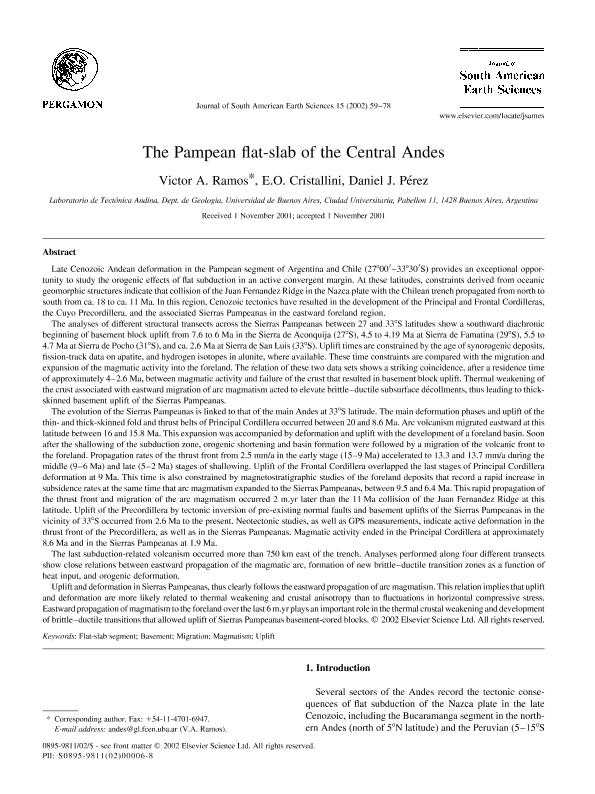Artículo
The Pampean flat-slab of the Central Andes
Fecha de publicación:
12/2002
Editorial:
Pergamon-Elsevier Science Ltd
Revista:
Journal of South American Earth Sciences
ISSN:
0895-9811
Idioma:
Inglés
Tipo de recurso:
Artículo publicado
Clasificación temática:
Resumen
Late Cenozoic Andean deformation in the Pampean segment of Argentina and Chile (27°00′-33°30′S) provides an exceptional opportunity to study the orogenic effects of flat subduction in an active convergent margin. At these latitudes, constraints derived from oceanic geomorphic structures indicate that collision of the Juan Fernandez Ridge in the Nazca plate with the Chilean trench propagated from north to south from ca. 18 to ca. 11 Ma. In this region, Cenozoic tectonics have resulted in the development of the Principal and Frontal Cordilleras, the Cuyo Precordillera, and the associated Sierras Pampeanas in the eastward foreland region. The analyses of different structural transects across the Sierras Pampeanas between 27 and 33°S latitudes show a southward diachronic beginning of basement block uplift from 7.6 to 6 Ma in the Sierra de Aconquija (27°S), 4.5 to 4.19 Ma at Sierra de Famatina (29°S), 5.5 to 4.7 Ma at Sierra de Pocho (31°S), and ca. 2.6 Ma at Sierra de San Luis (33°S). Uplift times are constrained by the age of synorogenic deposits, fission-track data on apatite, and hydrogen isotopes in alunite, where available. These time constraints are compared with the migration and expansion of the magmatic activity into the foreland. The relation of these two data sets shows a striking coincidence, after a residence time of approximately 4-2.6 Ma, between magmatic activity and failure of the crust that resulted in basement block uplift. Thermal weakening of the crust associated with eastward migration of arc magmatism acted to elevate brittle-ductile subsurface décollments, thus leading to thick-skinned basement uplift of the Sierras Pampeanas. The evolution of the Sierras Pampeanas is linked to that of the main Andes at 33°S latitude. The main deformation phases and uplift of the thin- and thick-skinned fold and thrust belts of Principal Cordillera occurred between 20 and 8.6 Ma. Arc volcanism migrated eastward at this latitude between 16 and 15.8 Ma. This expansion was accompanied by deformation and uplift with the development of a foreland basin. Soon after the shallowing of the subduction zone, orogenic shortening and basin formation were followed by a migration of the volcanic front to the foreland. Propagation rates of the thrust front from 2.5 mm/a in the early stage (15-9 Ma) accelerated to 13.3 and 13.7 mm/a during the middle (9-6 Ma) and late (5-2 Ma) stages of shallowing. Uplift of the Frontal Cordillera overlapped the last stages of Principal Cordillera deformation at 9 Ma. This time is also constrained by magnetostratigraphic studies of the foreland deposits that record a rapid increase in subsidence rates at the same time that arc magmatism expanded to the Sierras Pampeanas, between 9.5 and 6.4 Ma. This rapid propagation of the thrust front and migration of the arc magmatism occurred 2 m.yr later than the 11 Ma collision of the Juan Fernandez Ridge at this latitude. Uplift of the Precordillera by tectonic inversion of pre-existing normal faults and basement uplifts of the Sierras Pampeanas in the vicinity of 33°S occurred from 2.6 Ma to the present. Neotectonic studies, as well as GPS measurements, indicate active deformation in the thrust front of the Precordillera, as well as in the Sierras Pampeanas. Magmatic activity ended in the Principal Cordillera at approximately 8.6 Ma and in the Sierras Pampeanas at 1.9 Ma. The last subduction-related volcanism occurred more than 750 km east of the trench. Analyses performed along four different transects show close relations between eastward propagation of the magmatic arc, formation of new brittle-ductile transition zones as a function of heat input, and orogenic deformation. Uplift and deformation in Sierras Pampeanas, thus clearly follows the eastward propagation of arc magmatism. This relation implies that uplift and deformation are more likely related to thermal weakening and crustal anisotropy than to fluctuations in horizontal compressive stress. Eastward propagation of magmatism to the foreland over the last 6 m.yr plays an important role in the thermal crustal weakening and development of brittle-ductile transitions that allowed uplift of Sierras Pampeanas basement-cored blocks.
Palabras clave:
BASEMENT
,
FLAT-SLAB SEGMENT
,
MAGMATISM
,
MIGRATION
,
UPLIFT
Archivos asociados
Licencia
Identificadores
Colecciones
Articulos(IDEAN)
Articulos de INSTITUTO DE ESTUDIOS ANDINOS "DON PABLO GROEBER"
Articulos de INSTITUTO DE ESTUDIOS ANDINOS "DON PABLO GROEBER"
Citación
Ramos, Victor Alberto; Cristallini, Ernesto Osvaldo; Peréz, Daniel J.; The Pampean flat-slab of the Central Andes; Pergamon-Elsevier Science Ltd; Journal of South American Earth Sciences; 15; 1; 12-2002; 59-78
Compartir
Altmétricas




